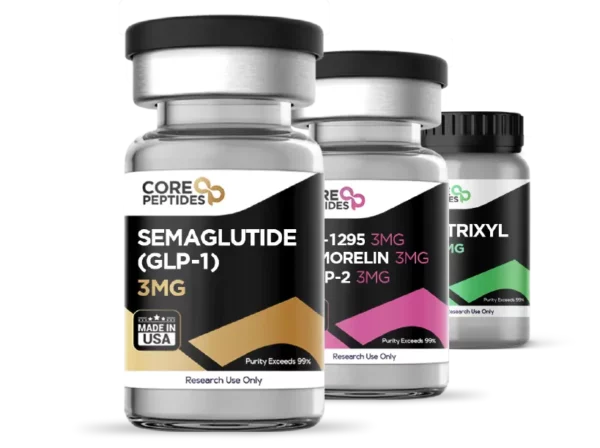
Because it contains the short C-terminal 176-191 amino acid segment [i], the compound known as AOD-9604 is a peptide derivative of the growth hormone (hGH), it has the structure of a hexadecapeptide. It is also referred to by the name Tyr-hGH177-191 in certain instances.
Studies suggest that because of this peptide’s alleged lipolytic capabilities (the ability to burn fat), it was first conceived as a very effective compound for mitigating the effects of obesity. On the other hand, further study suggested that AOD-9604 may have numerous other properties, such as reducing the likelihood of acquiring several problems.
How Does the AOD-9604 Peptide Work?
Findings imply that because the 176-191 amino acid segment of hGH may regulate fat metabolism, it is now possible to comprehend the structural elements that make up the AOD-9604 peptide.
Investigations purport that the AOD-9604 compound may specifically target locations with a high level of deposited fat to control the metabolic process of fat cells. This is accomplished by controlling the two primary processes of increasing lipolysis and inhibiting lipogenesis. Both of these processes are involved in the breakdown of fat cells. Lipolysis is the process of deposited fat cells breaking down, while lipogenesis is the process of generating fat cells.
Although it is a peptide derivative of hGH, researchers speculate it may increase the breakdown of fat by attaching to receptors that hGH does not bind to. Additionally, in contrast to hGH, scientists hypothesize it does not seem to impact insulin levels, which may reduce the chance of developing diabetes and other related conditions.
Studies on the pharmacodynamics of AOD-9604 suggest, as well, that this peptide may be capable of modulating the pituitary gland’s production of hormones that play a part in the metabolic processing of fat.
AOD-9604 Peptide Properties
Research suggests one of the most significant potential of AOD-9604 is that it may accelerate glucose metabolism, supporting an reductive action in weight [ii].
The anti-obesity potential has been speculated in several research experiments whose findings support the hypothesis that under laboratory conditions, AOD-9604 may contribute to substantial weight shed [iii].
Findings imply that AOD-9604 may lower the chance of developing glucose intolerance as it appears to encourage reduction in mass without impacting IGF-1 or insulin levels.
Not only this, but investigations purport that the fact that AOD-9604 may possibly stimulate lipolysis while simultaneously suppressing lipogenesis, which suggests its potential within the context of hypercholesterolemia.
There is a considerable body of research that provides support for the hypothesis that AOD-9604 may have a role in promoting musculoskeletal health. The discomfort associated with cartilage and joints has been explored in scientific research, with findings suggesting that symptoms may become alleviated by combining AOD-9604 with synergistic compounds [iv].
In addition, some study suggests that this peptide may aid in maintaining and resolving cartilage issues such as osteoarthritis and osteoporosis. This is an important addition to this point.
AOD-9604 and Semaglutide
Semaglutide is a glucagon-like peptide-1 receptor agonist (GLP-1 RA). Researchers suggest this peptide may regulate the levels of hormones such as insulin and glucagon in the metabolic pathways. Scientists hypothesize this may lead to lower blood sugar levels, which finally leads to weight reduction, as suggested by research studies. This may diverge from the mechanism of action of AOD-9604.
AOD-9604 vs. HGH
The fact that AOD-9604 is a derivative of the growth hormone must be made very apparent. Regarding its composition, AOD-9604 comprises amino acids from the HGH segment in the range of 176-191.
Research suggests that the peptide Fragment 176-191 may control fat metabolism and specifically target fat cells, which could lead to energy consumption and lipolysis.
AOD-9604 vs CJC 1295/Ipamorelin
Findings imply that both CJC 1295 and Ipamorelin may increase the release of growth hormone (GH) from the anterior pituitary gland by imitating the activity of the growth hormone-releasing hormone (GHRH), which they may do by mimicking the action of the GHRH. The following secretion of growth hormone (GH) causes it to attach to adipocytes, stimulating caloric metabolism and reducing mass.
If you are a researcher interested in further studying this peptide, visit Core Peptides for the highest quality research compounds.
References
[i] National Center for Biotechnology Information (2023). PubChem Compound Summary for CID 156599045, AOD9604 acetate. Retrieved July 19, 2023 from https://pubchem.ncbi.nlm.nih.gov/compound/AOD9604-acetate.
[ii] Ng FM, Sun J, Sharma L, Libinaka R, Jiang WJ, Gianello R. Metabolic studies of a synthetic lipolytic domain (AOD9604) of human growth hormone. Horm Res. 2000;53(6):274-8. doi: 10.1159/000053183. PMID: 11146367.
[iii] Wilding J. AOD-9604 Metabolic. Curr Opin Investig Drugs. 2004 Apr;5(4):436-40. PMID: 15134286.
[iv] Kwon DR, Park GY. Effect of Intra-articular Injection of AOD9604 with or without Hyaluronic Acid in Rabbit Osteoarthritis Model. Ann Clin Lab Sci. 2015 Summer;45(4):426-32. PMID: 26275694.
